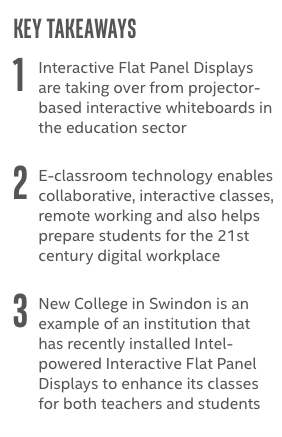
How new college in Swindon, UK, is using Intel-powered e-classroom technology to enhance classes, by Libby Plummer, technology writer for Intel
As expectations in education are changing, new technologies are beginning to transform classrooms for the 21st century. With an increasing amount of class material now online, connected technology is vital for enhancing student success. Whilst the edge-to-cloud e-classroom plays a vital role in supporting the increasing amount of video teaching materials, it also provides an easily accessible central repository for all the class-related content.

For those that grew up in the 1980s and earlier, blackboards and chalk were a standard feature of every classroom, soon replaced by whiteboards and marker pens in the ‘90s and projector-based Interactive Whiteboards (IWBs) in the early 2000s. Interactive Flat Panel Displays or IFPDs have now gradually started to become a standard feature for schools and colleges around the world, already appearing in more than 70 percent of US school classrooms.
Multi-touch IFPDs offer an array of benefits in comparison to their projector-based predecessors, including high-resolution visuals, multiple input capabilities, lower energy consumption and noise-free operation. These features enable IFPDs to drive the development of innovative software that allows truly creative collaboration. The fact that no replaceable parts, such as bulbs, are required means that maintenance costs are lower and Intel vPro technology can help reduce this further.
A more immersive learning environment helps them to drive collaboration and interaction to engage students
Intel vPro
The e-classroom supports 21st century interactive learning by untethering teachers from the front of the room, allowing more immersive teaching with ultra-high-definition 4K visuals and also enabling easy collaboration for everyone in the room and those who are participating remotely. What’s more, interactive panels are easy to install and integrate into existing IT infrastructure.
This new digital classroom environment has major advantages for teachers, enabling them to personalise learning as well as store and access course content easily. A more immersive learning environment helps them to drive collaboration and interaction to engage students, teaching them not only about the subject but also valuable digital skills. What’s more, it enables students to shift from merely consuming information in class to actively participating. As well as encouraging creativity, multimedia-rich e-classroom lessons help students to collaborate and present their work more effectively, preparing them for a modern 21st century workplace.
“Intel has been instrumental in making the e-classroom of the future a reality, enabling faster access to lesson material and supporting remote learning, as well as providing useful data insights on how classroom equipment is used”, says Alex Jones, collaboration segment marketing manager at Intel.
New College in Swindon, UK is currently trialling Intel-powered e-classroom technology, having recently installed a ViewSonic IFPD. “The installation at New College comprises four components,” explains Brian Wei, director of product marketing for Europe at ViewSonic. “The 75-inch ViewSonic IFPD is powered by the Intel Unite platform, thanks to an Intel-based Open Pluggable Specification (OPS) slot-in PC with Intel Core i5 CPU which is designed for these flat panels. From a user’s perspective, it’s like a giant Windows 10 Surface tablet. On the software side, it features our ViewBoard 2.1 whiteboard software”.
This interactive software enables teachers to write, erase, highlight, edit, annotate and draw on-screen documents and images. It also includes a magnifier and a screen recording function, which is particularly useful for capturing entire lessons so that students that are not present can catch up easily. A UK government report published in 2015 recommended that all publicly funded further education courses should include a wholly online component making up at least 10 percent of the entire course, while incentives should be offered to increase this to 50 percent by 2017/2018. The use of IFPDs with built-in capture technology makes these online classes a reality. ViewBoard also has one big advantage over some of its rivals in that it can easily open and display Microsoft Office* documents, and also convert new documents to Office formats for easy sharing.
“While the interactive element of the screen will probably be used less in higher education settings than it would be in primary or secondary schools, the biggest benefit for colleges and universities is distance learning,” says Wei. “New College is using Skype, to connect lecturers to students that cannot attend classes. This is where Intel Unite can really provide a huge benefit”.

Intel Unite conference room technology was originally designed for business use but is also ideal for the connected classroom. With Intel Unite running on an Intel-based Open Pluggable Specification (OPS) slot-in PC or a mini PC powered by Intel Core vPro processors, lessons can begin 70 percent faster, with average start times cut down from 7.5 to just 2 minutes. It enables the teacher to share their screen with the main display panel in the room as well as with the computers and tablets of the participants and it’s also easy for everyone involved to interact with the shared content.
IFPDs offer access to a vast new range of software to support a totally new way of learning that’s not only creative and collaborative, but also accessible for all
To ensure optimum security, all data shared across Intel Unite is encrypted, while the platform is also designed to seamlessly support Microsoft Windows (7, 8.1, 10), Apple Mac OS, Apple iPads, Android, Chromebook, and Linux.
In addition, Intel vPro technology provides advanced remote asset manageability which can drive efficiency and save costs. Meanwhile, IFPDs offer access to a vast new range of software to support a totally new way of learning that’s not only creative and collaborative, but also accessible for all. For example, the Microsoft Translator tool offers a translation cloud service which is particularly useful for foreign students studying abroad, enabling them to understand all of the course content and interact with it more easily. This system can also help to support hearing impaired students.
Virtual whiteboard software is also changing the way that lessons are conducted, making more efficient use of the teacher’s time
Virtual whiteboard software is also changing the way that lessons are conducted, making more efficient use of the teacher’s time. For example, the Microsoft Whiteboard app offers a collaborative digital canvas that can be used by multiple users at the same time, working from different devices. While the app has obvious business applications for teams that are dispersed around the globe, it’s aimed largely at the education sector, enabling students to interact with the main screen from their desk, and also supporting remote learning. All users can see what other people are adding to the virtual whiteboard in real time and the board can also be used to easily create graphs and even add in images using Bing search. What’s more, AI in the cloud can recognise objects that the user is trying to draw and tweak their sketches accordingly. For example, if the user roughly sketches a triangle, the AI will recognise what it’s supposed to look like and automatically render it more accurately with straight lines and even give measurements for all of the angles.
As well as supporting lessons, digital classroom technology can help to provide useful data, both in an educational and a business setting. The Intel Unite Telemetry Plugin can be used to collate usage data such as who is using the system, when and for how long. This can be used to provide insights that could help to make both lessons and business operations more efficient. For example, these analytics could be used to recognise which lessons are starting when, automatically calling up the relevant course content to enable classes to begin even more quickly.
Tony Gilbert, curriculum manager computing, business, travel and hospitality at New College, said: “New College Swindon has been using a ViewSonic interactive display board to help improve collaboration between lecturers and students. We have found that students are able to interact with their lessons more frequently by sharing their own work and annotating presentations delivered by lecturers. This is made possible by the built in software that is available on the board. Finally, I have been encouraged by students being able to make better notes because of the cross collaboration (students are adding their own views to presentations).
As a lecturer, using the board, I feel it will help enhance lessons and allow our learners to become more collaborative and preparing them for the workplace

“As a lecturer, using the board, I feel it will help enhance lessons and allow our learners to become more collaborative and preparing them for the workplace. In the workplace it is now becoming the norm to work collaboratively and put documents on the cloud, the board is helping to instil this notion. In addition, I strongly believe that teachers and lecturers are now facilitating learning because of increased student participation, engagement and collaboration.
“Lastly, as a lecturer I have found that using the board has saved me time because I can just clear the whiteboard with a click of a button rather than stand and clean a traditional board. I can also have presentations on multiple devices and connect to the board rather than waiting to login and then locate my presentations. I can use the presentations on the board for multiple groups. It is helping to reduce my admin and ensure that I am more organised!”
Class for the future
IFPDs are driving the classroom of the future by supporting interactive and collaborative lessons as well as enabling remote learning and the ability to gather useful data insights. And it’s not just limited to education. This kind of collaborative working, connecting team members who may be in different locations, can also help businesses to thrive in the new digital era. What’s more, transforming the classroom with new technologies and introducing students to digital working as early as possible also helps to create more productive workers for the digital workplace of the future, avoiding a potential skills gap.







